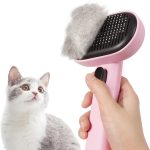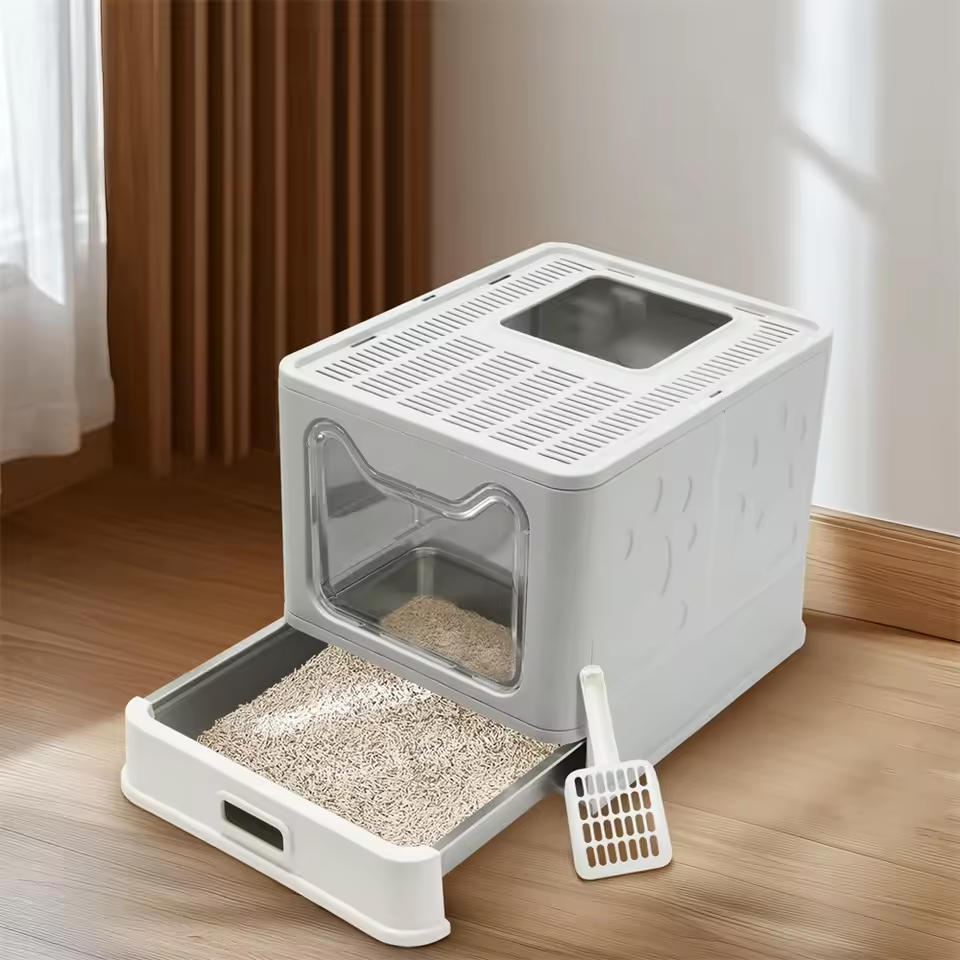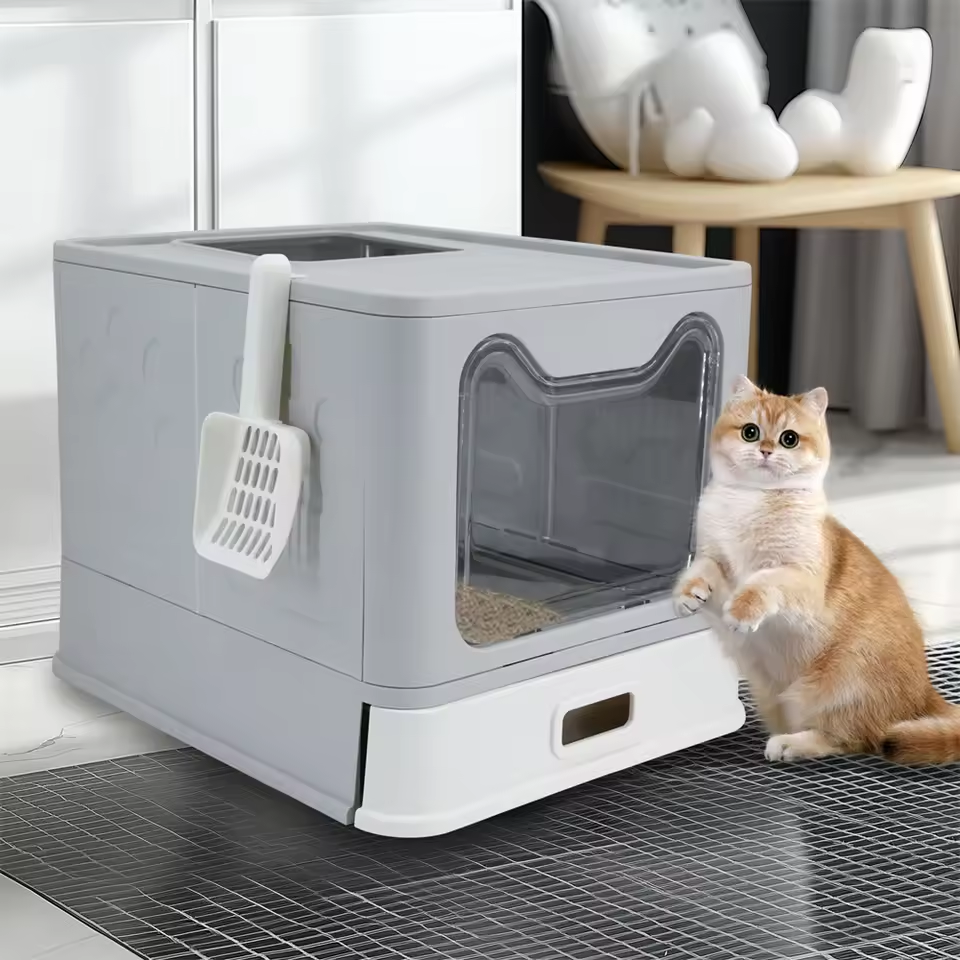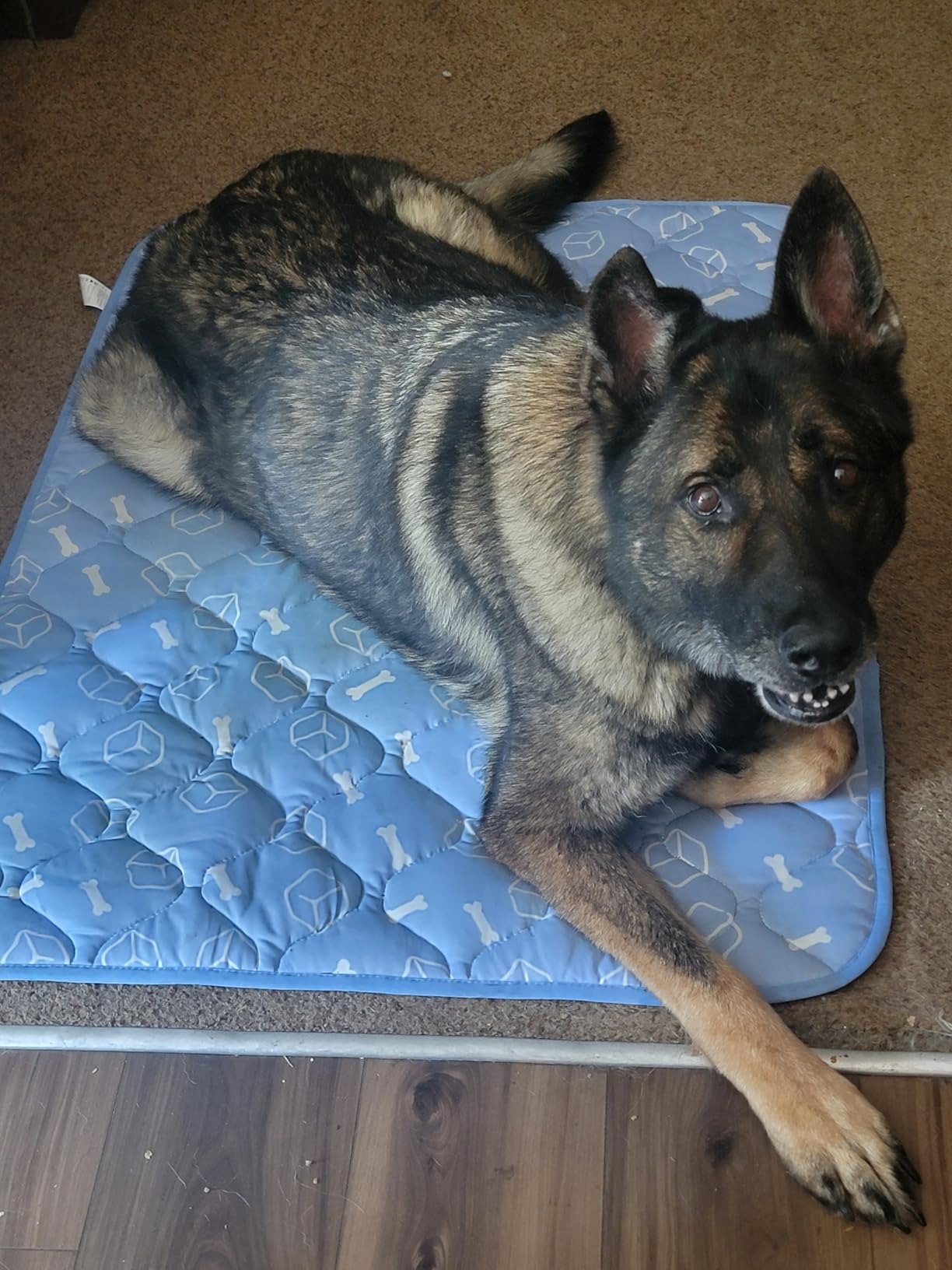Introduction to Top Entry Cat Litter Boxes
The top entry cat litter box is a modern solution designed to meet the unique needs of both cats and their owners. Unlike traditional open-style litter boxes, this enclosed design features a raised entrance that mimics a cat’s natural instinct to dig and eliminate in sheltered spaces. By prioritizing privacy, the top entry style reduces stress for cats while containing odors, litter scatter, and messes. This makes it ideal for households seeking a cleaner, more discreet option that blends into home decor.
Key benefits include odor control via ventilation systems or carbon filters, adjustable entry heights for cats of all sizes, and easy maintenance with removable trays or self-cleaning features. Additionally, some models integrate with hidden litter box furniture, such as bookshelf or armoire designs, to save space and enhance aesthetics. Whether you have a small apartment or a multi-cat household, choosing the right top entry cat litter box ensures your cat’s comfort while maintaining a tidy home environment. Always consider size, material, and accessibility to find the best fit for your feline’s behavior and your lifestyle.
Why Choose a Top Entry Design?
The top entry cat litter box stands out as a superior choice for cat owners due to its thoughtful design that balances feline comfort, hygiene, and home aesthetics. Here’s why this style is worth considering:
1. Prioritizes Feline Privacy
Cats are instinctively private creatures and often avoid using litter boxes in busy or exposed areas. The enclosed top entry design mimics a natural digging environment, providing seclusion that encourages cats to eliminate comfortably.
2. Reduces Mess and Odors
Traditional open boxes often scatter litter or spray urine, but top entry models minimize spills with raised edges and enclosed structures. Their ventilation systems or carbon filters trap odors while allowing airflow, eliminating the need for constant air fresheners. This makes them ideal for homes where cleanliness and scent control are priorities.
3. Encourages Regular Use
The raised entrance ensures cats can easily enter and exit, even for those with mobility issues. Covered designs also prevent litter from sticking to their paws, reducing tracking. Some self-cleaning models, like the Littermaid, automate scooping, further encouraging cats to return to a clean, fresh space.
4. Adapts to Behavioral Needs
Cats that dislike open exposure or struggle with narrow entryways (common in kittens or obese cats) thrive with top entry boxes.
In short, the top entry cat litter box addresses both practical and behavioral challenges, offering a harmonious solution for cats and their humans. Its blend of functionality, discretion, and adaptability makes it a standout choice in modern pet care.
Key Features to Look for in a Top Entry Litter Box
Selecting the right top entry cat litter box requires evaluating features that align with your cat’s behavior and your lifestyle. Below are the critical factors to prioritize for functionality, durability, and feline satisfaction:
1. Material Quality
Opt for durable, non-porous materials like heavy-duty plastic or stainless steel. These resist scratches, bacterial buildup, and odors. Avoid lightweight plastics that warp over time or porous surfaces that trap moisture.
2. Size and Entry Accessibility
The box should be 1.5x the length of your cat from nose to tail, allowing comfortable turning space. Adjustable entry heights accommodate cats of different ages or mobility levels.
3. Ease of Cleaning
Prioritize removable trays or detachable liners for quick scooping. Self-cleaning models, such as the Littermaid, automate waste removal, saving time. Ensure the design allows deep cleaning—nooks or hard-to-reach corners can harbor bacteria.
4. Odor and Moisture Control
Look for ventilation systems that balance airflow with odor containment. Carbon filters or activated charcoal inserts neutralize smells without harsh chemicals. Drainage holes or moisture-wicking liners help prevent mold.
5. Privacy and Comfort
Cats prefer enclosed spaces, so choose a lid that fully covers the box. Some models include soft bedding or textured floors to mimic natural digging surfaces. Avoid overly restrictive designs that might stress anxious cats.
6. Additional Features
- Quiet Mechanisms: Reduces noise that might startle cats.
- Multi-Cat Compatibility: Dual entries or divider panels for shared use.
- Sustainability: Recycled materials or refillable litter systems.
By prioritizing these features, you’ll find a top entry cat litter box that balances your cat’s comfort, your home’s cleanliness, and your budget. A well-chosen model minimizes accidents, reduces maintenance stress, and becomes a seamless part of your pet care routine.
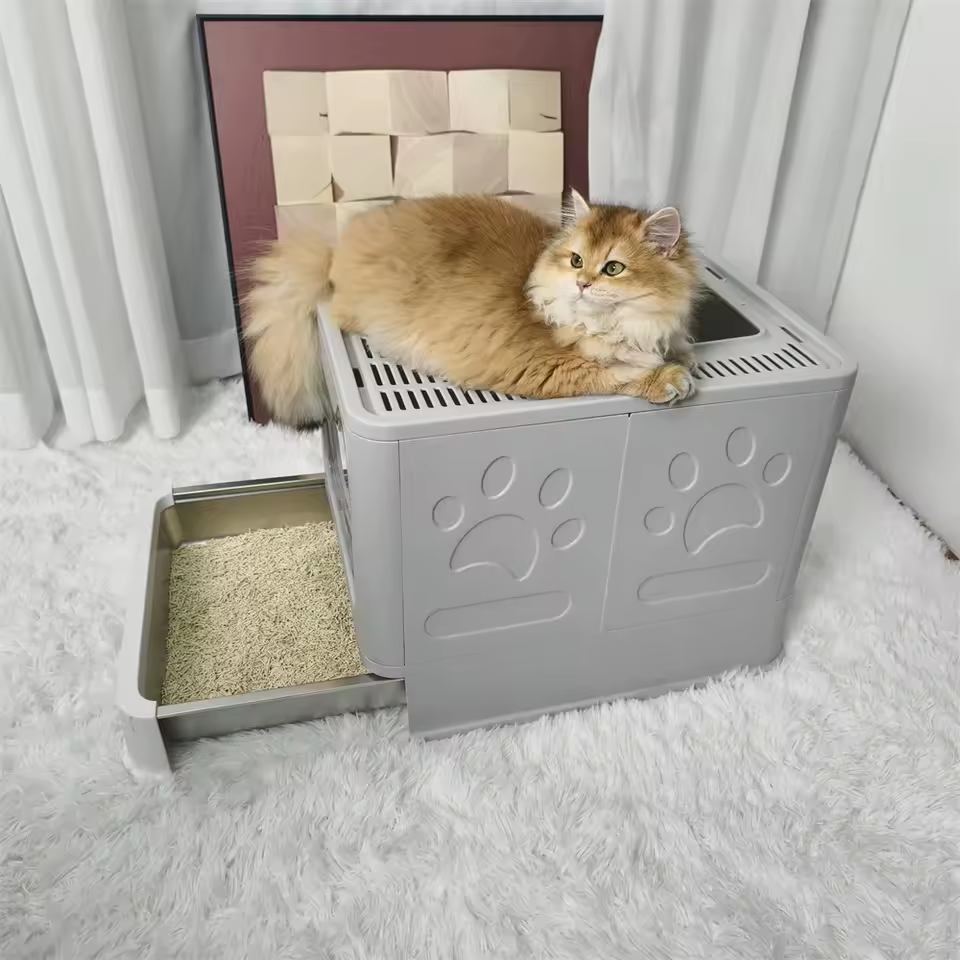
How to Choose the Right Size and Accessibility
Selecting the right size and accessibility for a top entry cat litter box ensures your cat uses it comfortably while fitting seamlessly into your home. Here’s how to make the best choice:
1. Measure Your Cat’s Dimensions
The box should be 1.5 times the length of your cat from nose to tail. For example, a 12-inch-long cat needs an 18-inch-long box. This allows room to turn, dig, and eliminate without feeling cramped. Overweight or large breeds require extra space to maneuver.
2. Prioritize Entry Width and Height
- Width: Ensure the entrance is at least 8–10 inches wide to prevent litter scattering and allow cats to enter easily.
- Height: Adjustable entries accommodate kittens or senior cats with mobility issues. A standard height of 6–8 inches works for most adults, but taller models suit taller breeds.
3. Multi-Cat Considerations
In multi-cat households, opt for larger models or those with dual entries to reduce territorial disputes. A box with a divider panel or extra space can also serve as a “safety zone” for nervous cats.
4. Hidden Furniture Compatibility
If using hidden litter box furniture, measure the compartment dimensions first. Ensure the box fits snugly without compromising your cat’s ability to enter or turn around.
5. Material and Structural Support
Choose lightweight yet sturdy materials for easy lifting. Avoid flimsy designs that tip over if your cat jumps out.
6. Test Before Finalizing
Let your cat explore the box before committing. Some may prefer lower entries or wider doors. Watch for hesitation or avoidance, which could signal a mismatch in size or accessibility.
By aligning the box’s dimensions and entry design with your cat’s physical needs and home setup, you’ll minimize accidents and ensure lifelong litter box acceptance.
Maintaining Cleanliness and Odor Control
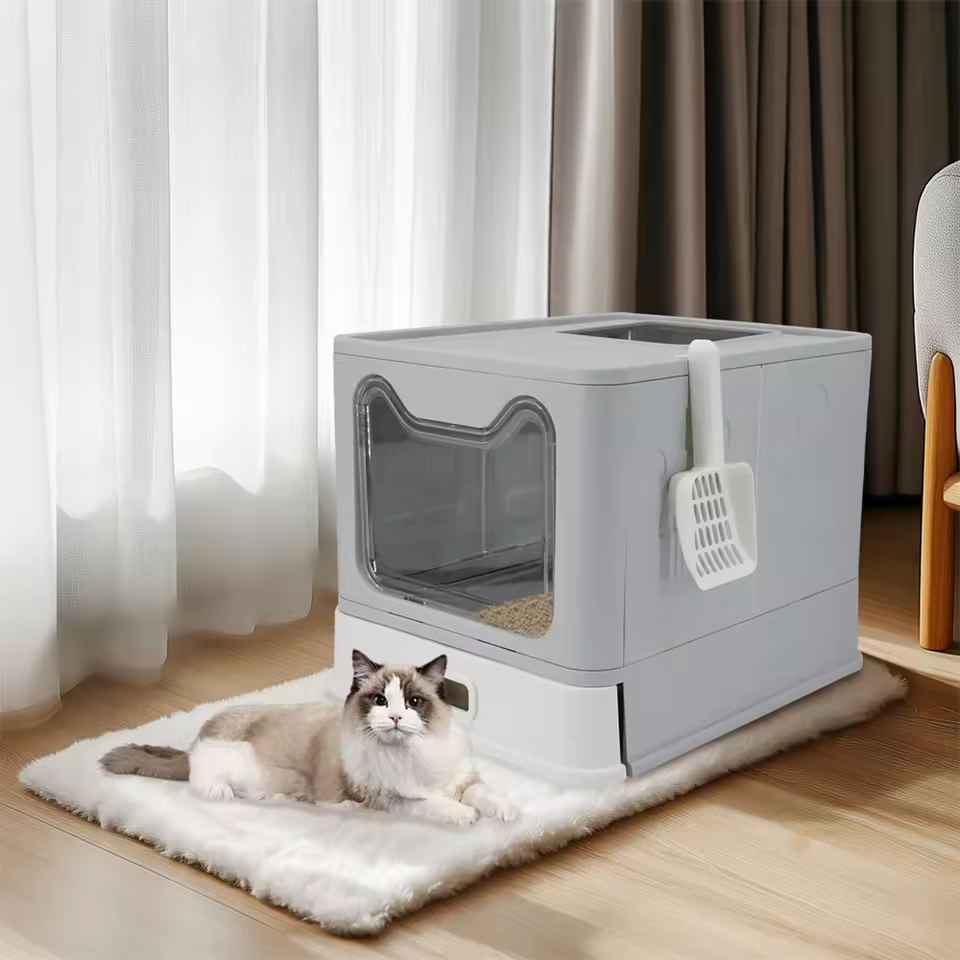
A top entry cat litter box requires consistent care to maintain hygiene, prevent odors, and ensure your cat continues using it. Follow these steps for optimal cleanliness:
1. Daily Maintenance
- Scoop Waste Immediately: Remove solid waste and clumps twice daily to prevent odor buildup. Use a long-handled scoop for enclosed boxes to avoid bending.
- Check Entryways: Wipe down the entrance and door handles with a damp cloth to remove litter residue or urine traces.
2. Weekly Deep Cleaning
- Empty and Rinse: Remove the litter tray, discard old litter, and rinse it with warm water. Avoid harsh chemicals—opt for enzyme-based cleaners that break down organic waste.
- Clean the Exterior: Wipe the box’s outer surface and lid with a mild detergent. Replace carbon filters if your model has them.
3. Litter Selection and Management
- Use unscented clumping litter, which forms firm clumps for easy removal and reduces tracking. Avoid fine-grained litters that dust or clog self-cleaning mechanisms.
4. Ventilation and Odor Control
- Ensure the box’s ventilation holes are unblocked to allow airflow.
- For hidden litter box furniture, open the compartment weekly to air it out.
5. Addressing Spills and Accidents
- Keep a small broom or handheld vacuum near the box to clean litter spills immediately.
- If urine leaks occur, spot-treat stains with an enzymatic cleaner to eliminate odors.
Common Mistakes to Avoid
- Skipping deep cleans leads to bacterial growth and persistent smells.
- Overfilling the litter tray traps moisture and increases clumping failures.
- Using bleach or ammonia-based cleaners can irritate cats’ sensitive noses.
By adhering to this routine, you’ll keep the top entry cat litter box fresh and inviting, reducing the risk of accidents and ensuring your cat’s continued trust in the space.
Integrating Hidden Litter Box Furniture
Hidden litter box furniture seamlessly blends a top entry cat litter box into your home’s decor while keeping the litter area discreet. Here’s how to choose and install it effectively:
1. Choose the Right Design
Opt for furniture that matches your room’s aesthetic:
- Bookshelf Units: Stackable shelves hide the litter box while adding storage.
- Armoire Cabinets: Mimic closet designs with sliding doors that open to reveal the box.
- Under-Stairs Solutions: Utilize unused vertical space in staircases or alcoves.
Ensure the furniture’s compartment is spacious enough for your chosen top entry cat litter box, allowing your cat to move freely.
2. Prioritize Accessibility
Position the furniture in a quiet, low-traffic area accessible to your cat. The entrance door should be easy to open and at a height your cat can reach. Avoid blocking the door with heavy items.
3. Ventilation and Odor Control
Select designs with ventilation slots or filters to prevent odor buildup. Add carbon inserts or odor-neutralizing pads inside the compartment. Avoid fully sealed units, as trapped moisture can cause mold.
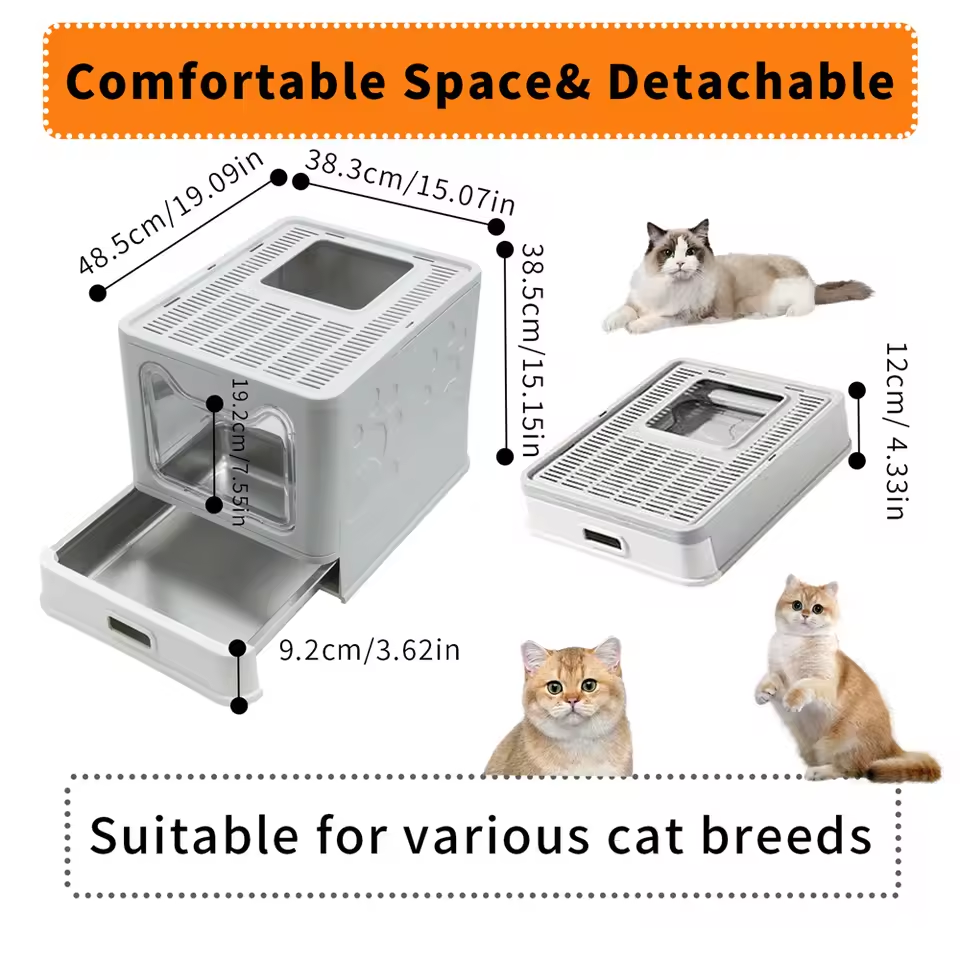
4. Maintenance Considerations
- Ensure the furniture’s door opens fully for easy cleaning.
- Use non-porous, wipeable surfaces for the interior.
- Regularly dust shelves and wipe down surfaces to maintain hygiene.
5. Test with Your Cat
Introduce your cat gradually:
- Open the door initially to let them explore the space.
- Place treats near the entrance to encourage investigation.
6. Space-Saving Tips
- Stack smaller litter boxes vertically in multi-shelf units.
- Use minimalist designs in small apartments.
By thoughtfully integrating hidden litter box furniture, you’ll create a stylish, functional space that satisfies both your cat’s needs and your home’s aesthetics.
Top Brands and Models to Consider
When choosing a top entry cat litter box, these reputable brands and models stand out for their quality, innovation, and cat owner reviews:
1. Littermaid Automatic Litter Box
- Key Features: Self-cleaning motor empties waste into a drawer daily, reducing manual scooping.
- Best For: Busy owners, multi-cat households.
- Model: Littermaid Ultra (wide entry, fits large breeds).
- Note: Requires electricity but saves time and reduces odors.
2. PetSafe ScoopFree Self-Cleaning Cat Box
- Key Features: UV sanitation system and flushable crystal litter eliminate odors.
- Best For: Allergy sufferers, eco-conscious owners.
- Model: ScoopFree XL (larger size with adjustable entry).
- Note: Litter requires regular refills but simplifies maintenance.
3. Kitty Litter House Covered Litter Box
- Key Features: Affordable, compact design with a removable tray and privacy hood.
- Best For: Budget-friendly options, kittens, or small cats.
- Model: Kitty Litter House Deluxe (adjustable door height).
- Note: Lightweight but durable—ideal for renters.
4. Modern Pet Ultra LitterBox
- Key Features: Tall, roomy design with a hinged lid for easy cleaning.
- Best For: Large breeds, seniors, or cats that dislike enclosed spaces.
- Model: Modern Pet Ultra LitterBox (fits up to 30-inch cats).
- Note: Integrates well with hidden litter box furniture due to its minimalist shape.
5. CatGenie Self-Cleaning System
- Key Features: Water-based cleaning and compostable waste bags.
- Best For: Those seeking eco-friendly, low-mess solutions.
- Model: CatGenie Elite (holds up to 30 days of waste).
- Note: Expensive upfront but reduces litter purchases long-term.
Choosing the Right Model
- Budget-Friendly: Kitty Litter House or Modern Pet.
- Self-Cleaning: Littermaid or CatGenie.
- Hidden Furniture Compatibility: Opt for compact, rectangular models like Modern Pet.
These brands prioritize durability, odor control, and cat comfort, ensuring a reliable match for your lifestyle and your feline’s preferences.
Common Mistakes to Avoid
Many top entry cat litter box users unknowingly make choices that frustrate their cats or compromise hygiene. Avoid these pitfalls to ensure satisfaction for both you and your pet:
1. Poor Location Selection
- Mistake: Placing the box in noisy, high-traffic areas or distant corners.
- Fix: Choose a quiet, easily accessible spot away from feeding areas.
2. Ignoring Size Requirements
- Mistake: Opting for a box too small for your cat’s size or breed.
- Impact: Cramped spaces lead to accidents or refusal to use the box.
3. Neglecting Regular Cleaning
- Mistake: Scooping infrequently or skipping weekly deep cleans.
- Impact: Odors and bacteria buildup repel cats and create health risks.
- Fix: Scoop twice daily, use enzyme cleaners, and replace litter weekly.
4. Overlooking Cat Preferences
- Mistake: Forcing a covered box on a cat that prefers open spaces.
- Impact: Cats may soil elsewhere to protest the design.
- Fix: Observe your cat’s behavior—some prefer top entry, while others need open access.
5. Incompatible Hidden Furniture
- Mistake: Choosing hidden litter box furniture with cramped compartments.
- Impact: Cats struggle to enter, defeating the purpose of the design.
- Fix: Ensure the furniture’s interior matches your box’s dimensions and allows easy entry.
6. Using the Wrong Litter
- Mistake: Opting for scented or fine-grained litter.
- Impact: Irritates cats’ noses or clogs self-cleaning mechanisms.
- Fix: Use unscented clumping or crystal litter for better performance.
7. Skipping Behavioral Training
- Mistake: Placing the box without introducing it gradually.
- Impact: Cats may resist using it due to unfamiliarity.
- Fix: Place treats near the entrance and leave the lid open initially to encourage exploration.
By avoiding these errors, you’ll create an inviting, functional space that respects your cat’s instincts while maintaining a clean home.
FAQs
Q: How often should I replace my top entry litter box?
A: Replace it every 1–2 years if it develops cracks or retains odors despite cleaning.
Q: Can I use any litter with a top entry box?
A: Avoid fine-grained litter to prevent clogging self-cleaning mechanisms. Stick to clumping or crystal litter.
Q: Is a top entry box suitable for kittens?
A: Yes, but choose a model with adjustable entry height to accommodate their growth.
Q: How do I train my cat to use it?
A: Place treats near the entrance and gradually close the lid after they’re comfortable.




